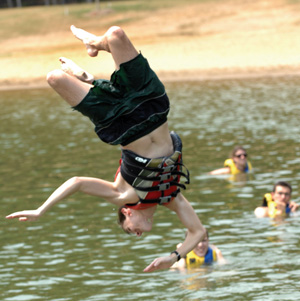
Jason Klug and fellow biomedical graduate students took the plunge into their studies, and Percy Priest Lake, last week. (photo by Neil Brake)
Grad students bringing research skills with them
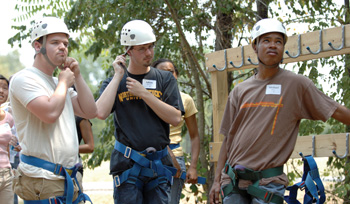
From left, Ryan Baldridge, Adam Ketron and Michael Irvin get ready for their turn on the zip line during orientation activities for incoming graduate students at the Joe C. Davis YMCA outdoor center. (photo by Neil Brake)
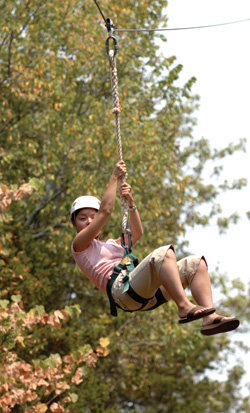
Alyssa Johnson goes for a ride on the zip line during last week’s outing. (photo by Neil Brake)
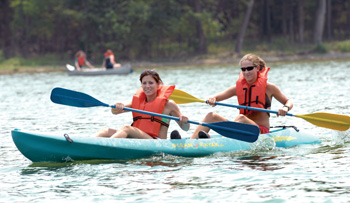
Jessi Mazerik, left, and Mallory Hacker synchronize their efforts at Percy Priest Lake. (photo by Neil Brake)
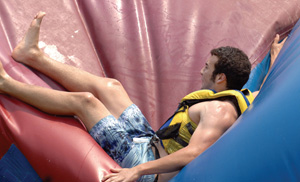
Dario Gutierrez takes a bounce on the inflatable at the outdoor center. (photo by Neil Brake)
Vanderbilt's newest biomedical graduate students plunged into their studies last week — literally.
The 86 entering students enjoyed orientation activities at the Joe C. Davis YMCA Outdoor Center, where they bounced and belly-flopped into Percy Priest Lake as they got to know each other and learned more about the graduate program.
This year's group brings more research experience than ever to campus.
“Over the past few years, we have found that more and more students have had some kind of research experience before starting graduate school,” said James Patton, Ph.D., director of the Interdisciplinary Graduate Program (IGP), one of the programs for graduate students interested in biological and biomedical research. “Now, if a student hasn't done significant research — usually at both the undergraduate institution and elsewhere — that student probably won't get an offer from the IGP.”
Marc Grenley is a good example. After completing undergraduate studies at Washington State University, where he participated in research projects, he worked for two years in a laboratory at the Fred Hutchinson Cancer Research Center. He speaks fluently of transgenic and knockout mice technologies, growth factor signaling, and developmental biology.
Having students enter graduate school with this kind of “extensive and fairly sophisticated research knowledge” is a change, said G. Roger Chalkley, D. Phil., senior associate dean for Biomedical Research Education and Training. “I wouldn't get into graduate school here, based on my experience at the time I was applying.”
Vanderbilt's interdisciplinary program, with its wide variety of research options, continues to be attractive to students. More than 80 percent of respondents to an ongoing survey said research opportunities were “extremely significant” in their decision to attend Vanderbilt, said Michelle Grundy, Ph.D., assistant director of Graduate Programs in Biomedical Sciences.
“I really liked that there was so much different research and so many different faculty members to choose from,” said Cody Smith, a graduate of Mercyhurst College in Erie, Penn.
“I'm interested in the intersection between biology, chemistry and medicine,” said Michele LeNoue-Newton, a graduate of the University of Louisville. “Vanderbilt's program was a perfect fit for me.”
The collegial and friendly environment at Vanderbilt and the support network for graduate students were also draws for the incoming students.
“Graduate students seem to matter here, more than at other schools,” said Jessi Mazerik, a graduate of Ohio State University.
The IGP welcomed 71 new students, and the Chemical and Physical Biology (CPB) Program enrolled five new students.
Three students were directly admitted to certain departments, and seven students are part of the IMSD (Initiative for Maximizing Student Diversity) program.
The new students graduated from 63 different colleges and universities; the group is 48 percent female.
The IGP recruits and educates graduate students who are interested in biological and biomedical research. The CPB program is aimed at students with a quantitative sciences background who wish to pursue research in areas that span the boundaries of the chemical, physical, and biological sciences.
Both programs organize the training — coursework and laboratory rotations — of students during their first year at Vanderbilt. At the end of the first year, students choose mentors and home departments or programs where they complete their coursework and doctoral dissertation research.
Programs and departments participating in the IGP include Biochemistry, Biological Sciences, Cancer Biology, Cell & Developmental Biology, Human Genetics, Microbiology & Immunology, Molecular Physiology & Biophysics, Neuroscience, Pathology, and Pharmacology. The CPB program includes a subset of IGP faculty interested in structural and chemical biology as well as members of the departments of Chemistry, Mathematics and Physics.
After bonding at the YMCA Outdoor Center, the students arrived on campus for introductions to the departments and programs, biosafety, environmental and radiation safety training and “Responsible Conduct of Research” — a daylong course focused on regulatory and ethical research-related issues. They started classes on Monday.
For more information about biomedical research education and training at Vanderbilt, go to http://bret.mc.vander-bilt.edu/bret/.













